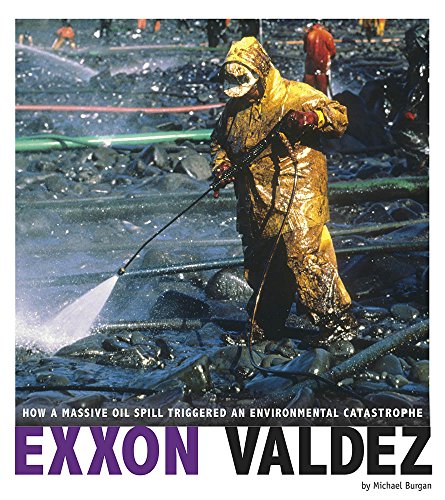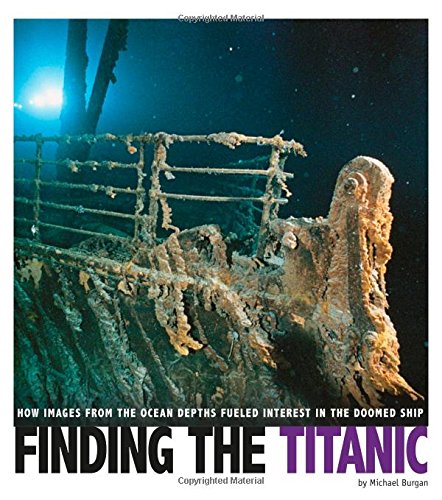-
Civil War Witness: Mathew Brady's Photos Reveal the Horrors of War
Don Nardo, Bob Zeller
Library Binding (Compass Point Books, July 1, 2013)Mathew Brady recognized that the new art of photography could be more than just a means of capturing people's likenesses in portraits. Beginning with the First Battle of Bull Run in 1861 and continuing through the entire Civil War, Brady and his employees chronicled the long, bloody conflict, bringing images of war directly to the people. Brady knew the photos would create valuable historical records for later generations. More than any other photographer of his generation, Brady understood photography's great potential and through his influence, he taught others to understand it as well. Z
Z
-
Trash Vortex: How Plastic Pollution Is Choking the World's Oceans
Danielle Smith-Llera
Library Binding (Compass Point Books, Jan. 1, 2018)Millions of tons of plastic slip into oceans every year. Some floats and travels slowly with the currents, endangering the health of marine animals. The rest is hardly visible but is far more dangerous. Tiny bits of plastic sprinkle the ocean's surface or mix into the sandy seafloor and beaches. It ends up inside birds, fish, and other animals, harming them-and ultimately humans. Experts struggle with fear and hope as they work to stop the flood of plastic threatening living organisms across the globe. Z
Z
-
Ground Zero: How a Photograph Sent a Message of Hope
Don Nardo
Library Binding (Compass Point Books, Aug. 1, 2016)The tragic events of September 11, 2001 sent shockwaves around the globe that are still felt today. Nearly 3,000 people died in the terrorist attacks and thousands more were injured. On the afternoon of the attacks, three firefighters paused in their rescue work to raise an American flag at Ground Zero in New York City. In the midst of horror and despair, the iconic photo of the men would remind Americans that they were far from beaten. It represented the country's strength, courage, decency, and its hope for the future. Z
Z
-
Raising the Flag: How a Photograph Gave a Nation Hope in Wartime
Michael Burgan, Kathleen Baxter, Alexa L. Sandmann Ed.D.
Library Binding (Compass Point Books, Dec. 1, 2010)By February 1945 the United States had been fighting World War II for more than three years. Soldiers were worn down from battle, and civilians were drained by sacrifice. But a photograph of Marines raising an American flag on Japanese soil gave a wearied nation a renewed sense of pride and hope. This powerful image of strength and determination became the most famous image of the war. It not only captured a moment of victory against a strong foe. It also represented the effort every member of the armed forces had made and offered Americans the promise of victory and an end to conflict. Y
Y
-
Assassination and Its Aftermath: How a Photograph Reassured a Shocked Nation
Don Nardo
Library Binding (Compass Point Books, July 1, 2013)The world was shocked and frightened when President John F. Kennedy was gunned down by an assassin's bullet in 1963. What would happen to the government of the most powerful nation on Earth? When Kennedy's vice president, Lyndon Baines Johnson, took the presidential oath of office on Air Force One just hours after the assassination, the White House photographer was there. Cecil Stoughton's iconic photo showed the world that the smooth and orderly transfer of power called for in the U.S. Constitution had occurred. His photo helped ease the shock, tension, and fear in an anxious country. Y
Y
-
Exxon Valdez: How a Massive Oil Spill Triggered an Environmental Catastrophe
Michael Burgan
Paperback (Compass Point Books, Jan. 1, 2018)The biggest oil spill in U.S. history that polluted the pristine waters of Alaska decades ago and killed thousands of birds, mammals, and fish, still haunts the people who are living with its aftermath. On Good Friday 1989, the huge oil tanker, Exxon Valdez, ran aground in Prince William Sound, spilling millions of gallons of crude oil into the water-oil that would eventually cover more than 1,000 miles of shoreline. Cleanup began immediately but there is still oil in the sound and Alaskans say life will never be the same. Z
Z
-
Inside the Situation Room: How a Photograph Showed America Defeating Osama bin Laden
Dan Elish
Library Binding (Compass Point Books, Aug. 1, 2018)On-point historical photographs combined with strong narration bring the story of the raid that captured bin Laden to life. Kids will feel as though they are in the room with President Barack Obama, Secretary of State Hillary Clinton, and the others in the cabinet who called for and monitored the raid. Primary source quotations make the event feel immediate, and photographs by the White House photographer add to the immediacy, and the understanding of the risks and dangers posed by the ultimately successful mission. Z
Z
-
Finding the Titanic: How Images from the Ocean Depths Fueled Interest in the Doomed Ship
Michael Burgan
Paperback (Compass Point Books, Aug. 1, 2017)On the night of April 14, 1912, as it made its first voyage, the luxury steamship Titanic struck an iceberg. Then, a few hours after midnight on April 15, the ship sank thousands of feet before settling on the ocean floor. And that's where it stayed, whereabouts unknown, for the next 73 years until it was discovered by oceanographer Robert Ballard and his crew. The pictures and video Ballard brought back from the 1985 discovery helped stir new interest in the Titanic's voyage and its resting spot. Y
Y
-
Man on the Moon: How a Photograph Made Anything Seem Possible
Pamela Jain Dell, Kathleen Baxter
Library Binding (Compass Point Books, Dec. 1, 2010)It is a bizarrely beautiful image: A man in a spacesuit stands isolated in an alien world. His companion, the photographer, and their landing craft are reflected in his visor. This photograph, taken by Neil Armstrong of fellow astronaut Buzz Aldrin, is the most famous documentation of Americas 1969 moon landing. But to people in every country on Earth, it representedand still doesso much more. The man in the photograph was hundreds of thousands of miles away from his home planet. He had conquered another world. It was, as Armstrong said, a giant leap for mankind. The photo of this historic event remains one of the most powerful and inspiring representations of the achievements of humankind. Y
Y
-
History of Gymnastics
Kenny Abdo
Library Binding (Abdo Zoom, Aug. 1, 2019)This title focuses on the history of Gymnastics and gives information related to its origins, fun facts, and superstars like Simone Biles. This hi-lo title is complete with epic and colorful photographs, simple text, glossary, and an index. Aligned to Common Core Standards and correlated to state standards. Fly! is an imprint of Abdo Zoom, a division of ABDO. O
O
-
Fukushima Disaster: How a Tsunami Unleashed Nuclear Destruction
Danielle Smith-Llera
Paperback (Compass Point Books, Jan. 1, 2018)A massive tsunami caused by the strongest earthquake to ever hit Japan triggered the world's worst nuclear crisis since the Chernobyl accident 25 years earlier. The monster waves that crashed into the Fukushima Daiichi nuclear plant in March 2011 killed 15,000 people and caused nuclear reactor meltdowns that threatened the lives of thousands more. The waves receded long ago, but the devastating effects of the nuclear accident still linger. Z
Z
-
The Blue Marble: How a Photograph Revealed Earth's Fragile Beauty
Don Nardo, James H Gerard
Paperback (Compass Point Books, March 1, 2014)The astronauts headed to the moon in December 1972 thought they knew what to expect. They would soon be exploring the moon’s surface in a lunar rover, traveling farther than anyone before them. They would be collecting soil and rock samples for study back on Earth and could expect to learn about the moon’s physical makeup and age. But what they didn’t expect came as a huge bonus. The astronauts of Apollo 17 would produce an amazing photograph of planet Earth a lonely globe floating in inky black space. Their stunning Blue Marble image was destined to become one of the most reproduced and recognizable photos in history. And no one is 100 percent sure who took it. Y
Y